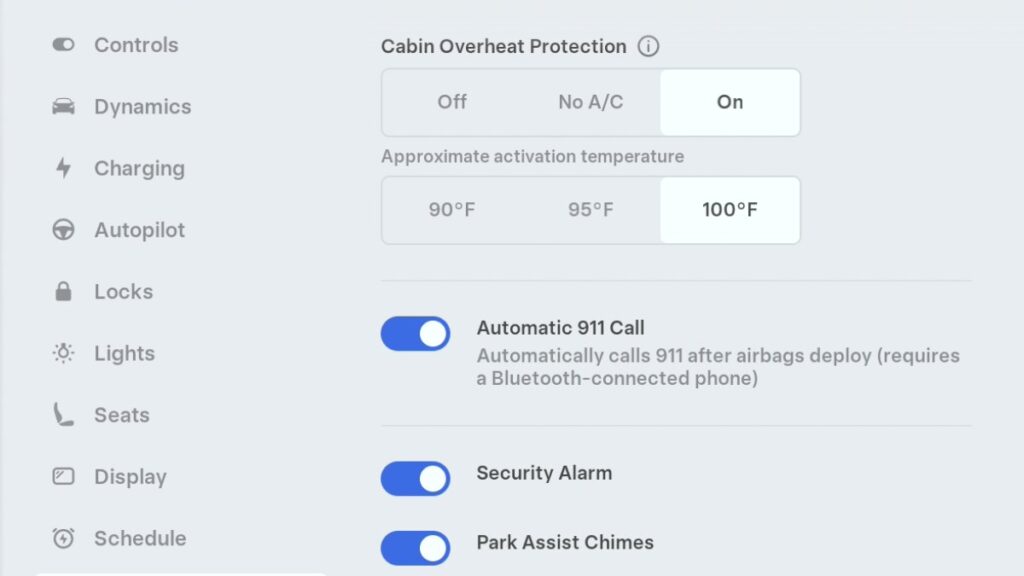Tesla’s Cabin Overheat Protection: A Guide to Using This Feature
Your Tesla comes equipped with a range of features designed to enhance your comfort and safety, and one such feature is Cabin Overheat Protection (COP). While your car’s materials and equipment are built to withstand high temperatures, COP is specifically designed to prevent the interior from becoming excessively hot when parked.
But what exactly does Cabin Overheat Protection do, how does it work, and when should you use it? Let’s explore further.
Understanding Cabin Overheat Protection
Cabin Overheat Protection is a climate control feature that automatically activates after you’ve left your vehicle. Its main purpose is to regulate the interior cabin temperature on hot days, ensuring that surfaces like the seats, steering wheel, and screen remain at a comfortable temperature.
In addition to keeping the interior cool, Cabin Overheat Protection can also help protect temperature-sensitive items from extreme heat. However, its primary function is to prevent the cabin from reaching dangerously high temperatures.
By using Cabin Overheat Protection for short periods, you can actually reduce the energy spent on cooling your vehicle, as it’s more efficient to maintain a temperature rather than cooling it down from extremely high temperatures. However, in most cases, using Cabin Overheat Protection will result in additional energy consumption.
It’s important to note that Cabin Overheat Protection is not designed to protect people or pets. For that purpose, Tesla offers dedicated features like “Dog Mode” or “Keep Climate On” that provide more comprehensive control over the internal temperature.
How to Enable Cabin Overheat Protection
Tesla offers several options for setting up cabin overheat protection, allowing you to customize when and how it operates. You can enable this feature either in your vehicle or through the Tesla app.
In the Vehicle: Navigate to Controls > Safety > Cabin Overheat Protection.
Via the Tesla App: Go to the Climate section, swipe up, and toggle Cabin Overheat Protection.
Customizing Cabin Overheat Protection Settings
When enabling Cabin Overheat Protection, you can choose from three settings:
Off: The system is completely disabled and will not activate when the vehicle is parked. This is the default setting.
No A/C: In this mode, if the interior temperature exceeds your set threshold, your vehicle will use only the HVAC fan to circulate outside air through the cabin. This helps cool the vehicle by bringing in cooler outside air.
On: When the interior temperature surpasses your set threshold, the system will use both the fan and air conditioning to actively cool the cabin and maintain it below the specified temperature. This is the most effective cooling option but also consumes a significant amount of energy.
You can also set a Temperature Threshold for activating Cabin Overheat Protection, with options ranging from 90°F to 100°F. The feature will work to maintain your vehicle at the set temperature while it is active.
Understanding Battery Drain
The primary reason for opting to disable Cabin Overheat Protection is its energy impact, which can increase your costs and reduce your vehicle’s range. This feature keeps your vehicle’s HVAC system running (or at least its fans) to help cool the cabin.
While the No A/C mode consumes minimal energy, the On mode (which uses air conditioning) will noticeably drain the battery, especially on hot days when the system works harder to maintain the set temperature.
The amount of energy consumed by Cabin Overheat Protection will vary depending on the activation temperature, external temperature, and whether your vehicle is parked in direct sunlight. Generally, the energy impact will be minimal when set to No A/C and significant when set to On.
It’s important to note that Cabin Overheat Protection will automatically turn off after 12 hours of operation or if the vehicle’s state of charge drops below 20%. This feature, along with several others in Tesla vehicles, can increase the cost of using your vehicle.
Do You Really Need Cabin Overheat Protection?
While Cabin Overheat Protection is a valuable feature that enhances the comfort of your Tesla, it is not essential. Tesla vehicles and their interior components are designed to withstand a range of temperature conditions, including both hot and cold.
While using Cabin Overheat Protection can potentially provide some benefits in terms of preserving the interior surfaces, its primary purpose is to ensure the comfort of occupants upon their return.
Dealing with Extreme Cold
Cabin Overheat Protection is designed to address heat-related issues and will not prevent your vehicle from becoming too cold. In extremely cold weather, Tesla vehicles have mechanisms in place to keep the high-voltage battery within a safe temperature range, even when you’re not in the car.
To ensure optimal comfort in cold weather, you can precondition your vehicle to warm up the cabin and battery for improved performance.
In conclusion, Cabin Overheat Protection is a useful feature that enhances the comfort of your Tesla, especially during hot weather. While it may not be necessary for everyone, it can be beneficial in certain situations, such as when parked in extreme heat or when protecting sensitive items in the car.
Overall, understanding how Cabin Overheat Protection works and its impact on energy consumption can help you make informed decisions about when to use this feature and how to optimize its settings for your specific needs.

